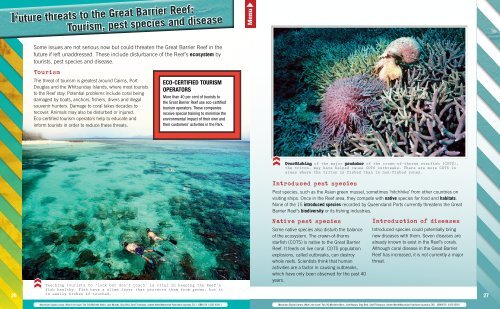GREAT BARRlER REEF - Saint Ignatius' Moodle Community
GREAT BARRlER REEF - Saint Ignatius' Moodle Community
GREAT BARRlER REEF - Saint Ignatius' Moodle Community
Create successful ePaper yourself
Turn your PDF publications into a flip-book with our unique Google optimized e-Paper software.
Some issues are not serious now but could threaten the Great Barrier Reef in the<br />
future if left unaddressed. These include disturbance of the Reef’s ecosystem by<br />
tourists, pest species and disease.<br />
Tourism<br />
The threat of tourism is greatest around Cairns, Port<br />
Douglas and the Whitsunday Islands, where most tourists<br />
to the Reef stay. Potential problems include coral being<br />
damaged by boats, anchors, fishers, divers and illegal<br />
souvenir hunters. Damage to coral takes decades to<br />
recover. Animals may also be disturbed or injured.<br />
Eco-certified tourism operators help to educate and<br />
inform tourists in order to reduce these threats.<br />
Eco-certified tourism<br />
operators<br />
More than 40 per cent of tourists to<br />
the Great Barrier Reef use eco-certified<br />
tourism operators. These companies<br />
receive special training to minimise the<br />
environmental impact of their own and<br />
their customers’ activities in the Park.<br />
Overfishing of the major predator of the crown-of-thorns starfish (COTS),<br />
the triton, may have helped cause COTS outbreaks. There are more COTS in<br />
areas where the triton is fished than in non-fished zones.<br />
Introduced pest species<br />
26<br />
Teaching tourists to ‘look but don’t touch’ is vital in keeping the Reef’s<br />
fish healthy. Fish have a slime layer that protects them from germs, but it<br />
is easily broken if touched.<br />
Pest species, such as the Asian green mussel, sometimes ‘hitchhike’ from other countries on<br />
visiting ships. Once in the Reef area, they compete with native species for food and habitats.<br />
None of the 15 introduced species recorded by Queensland Ports currently threatens the Great<br />
Barrier Reef’s biodiversity or its fishing industries.<br />
Native pest species<br />
Some native species also disturb the balance<br />
of the ecosystem. The crown-of-thorns<br />
starfish (COTS) is native to the Great Barrier<br />
Reef. It feeds on live coral. COTS population<br />
explosions, called outbreaks, can destroy<br />
whole reefs. Scientists think that human<br />
activities are a factor in causing outbreaks,<br />
which have only been observed for the past 40<br />
years.<br />
Introduction of diseases<br />
Introduced species could potentially bring<br />
new diseases with them. Seven diseases are<br />
already known to exist in the Reef’s corals.<br />
Although coral disease in the Great Barrier<br />
Reef has increased, it is not currently a major<br />
threat.<br />
27<br />
Macmillan Digital Library: What’s the Issue? Set 2 © Michelle Atkins, Julie Murphy, Greg Reid, Geoff Thompson, Ashten Warfe/Macmillan Publishers Australia 2011 ISBN 978 1 4202 9209 1 Macmillan Digital Library: What’s the Issue? Set 2 © Michelle Atkins, Julie Murphy, Greg Reid, Geoff Thompson, Ashten Warfe/Macmillan Publishers Australia 2011 ISBN 978 1 4202 9209 1







